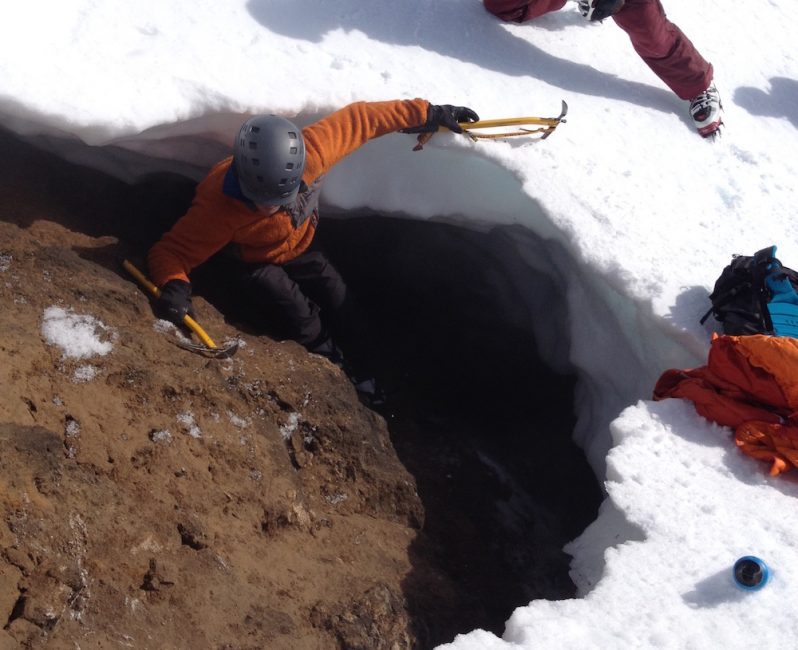Erik Broms was climbing down from the summit of Mount Hood Saturday morning when two climbers roped together came plummeting down the mountain, right at him.
“Somebody yelled ‘Falling!’ and I looked up, and here they come,” Broms recalls. “I had to hesitate for a moment to make sure that if I stepped one way or the other they weren’t going to go in that direction. Basically I waited until the last possible moment and then moved out of their path.”
Broms, an experienced rescue leader with Portland Mountain Rescue who has summited Mount Hood “somewhere between 225 and 250” times, responded quickly to help the fallen climbers below.
“I got to their location in about 2 minutes, and already they were both just shivering like crazy,” he says. “After a fall like that when you’re all busted up, you start losing body heat real fast. You just start getting cold immediately.”
The fallen climbers were a married couple, Michelle and Brian Carlson of Portland, and they were seriously injured and in shock after falling 450 feet. Their crampons had gotten caught up in the ice and snow as they tumbled, wrenching their legs and resulting in two broken ankles and a broken leg.
Fortunately, it was a mild weekend day on the mountain, and there were plenty of climbers and rescue experts around to help. PMR rescue leader Mark Morford radioed for help, contacting another PMR rescue team that was training down near Timberline Lodge. Another PMR volunteer, an emergency room physician’s assistant named J. Pearce Beissinger who runs an outfit called Vertical Medicine Resources, assessed the injuries of the fallen climbers and actually called in a prescription for pain meds from the mountain.
A dozen or so volunteer climbers rushed over to help, offering blankets, heat packs, food and water and using their backpacks to create a human shield around the Carlsons, to fend off falling ice.
Paramedics from American Medical Response were on their way to help, but Broms decided to call in for air support to fly the injured climbers to safety as quickly as possible. “We weren’t relying on a helicopter,” he says, “but if it is available it is definitely the fastest way to get some seriously injured people off the mountain.”
Just after they called in for a helicopter, about an hour after the Carlsons fell, another climber fell.
This climber, 29-year-old Karthik Jambunathan of Hillsboro, tumbled down and fell into a fumarole — essentially a hole in the ice and snow where the volcano vents sulphur and steam.
“He wasn’t injured but he was shaken up,” says Broms. “He took a pretty good bounce. He hit the downhill side of the fumarole, the lip, and he bounced up maybe two or three feet and went right down into the hole. I mean, it was pretty scary. If you had been there, you probably would have thought, ‘Jeez, that guy’s dead.'”
Fortunately, Jambunathan was okay. But he was stuck.
“He was wedged in,” says Broms. “He probably would not have been able to get out of that situation had we not been there, because he was sandwiched between the snow and the rock, down about 15 feet inside this hole.”
Again, nearby climbers responded quickly. Broms set an anchor, got Beissinger on a rope, and lowered him down into the hole. With time and effort they were able to help out Jambunathan, who was uninjured but very shaken up. A rescue volunteer helped him down to the top of Timberline’s Palmer Lift, and he caught a ride down to Timberline Lodge in a snowcat.
Meanwhile, the Carlsons were still waiting for the Oregon National Guard helicopter — and it ended up being a long wait. The helicopter arrived at around 4 pm, landing in the firm snow near the Devil’s Kitchen. Rescue personnel loaded the injured climbers and successfully transported them down to Legacy Emanuel Medical Center in Portland as darkness was descending on the mountain.
Broms has been climbing Mount Hood for 20 years and volunteering with PMR for 14 years. He says he worries that the ever-increasing popularity of Mount Hood could be luring up climbers who may not have the skills, fitness and training for a safe climb.
“We are seeing more and more inexperienced people climbing,” he says. “You can look around at the other people climbing and get a sense of their ability level — and some of these people just don’t look that experienced from what I’m seeing. I saw a couple of people that day just kind of scooching along on their butts, which is a big no-no. That’s like down-climbing a ladder facing out. You really don’t do that.”
Broms and other search-and-rescue experts emphasize that no one should set out to climb Mount Hood with the assumption that rescue teams and a helicopter will be ready and waiting to lift them to safety if they fall or get stuck. Only people with proper gear, training and fitness should attempt to climb to 11,249 feet on Mount Hood — no matter how mellow the weather and snow conditions may seem.
Last modified: February 4, 2015

